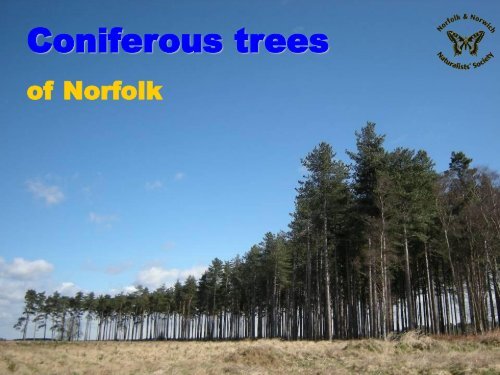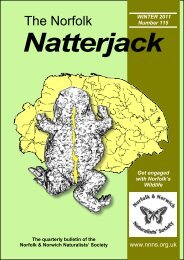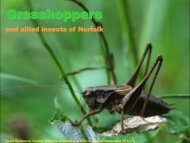Coniferous trees - Norfolk and Norwich Naturalists' Society
Coniferous trees - Norfolk and Norwich Naturalists' Society
Coniferous trees - Norfolk and Norwich Naturalists' Society
You also want an ePaper? Increase the reach of your titles
YUMPU automatically turns print PDFs into web optimized ePapers that Google loves.
<strong>Coniferous</strong> <strong>trees</strong><br />
of <strong>Norfolk</strong>
Copyright<br />
<strong>Norfolk</strong> & <strong>Norwich</strong> Naturalists’ <strong>Society</strong> (registered charity 291604)<br />
Text <strong>and</strong> photographs by David Richmond (except where stated otherwise)<br />
This is one of three presentations on the Trees of <strong>Norfolk</strong> covering:<br />
Part 1: Broadleaf <strong>trees</strong><br />
Part 2: Shrubs <strong>and</strong> smaller <strong>trees</strong><br />
Part 3: <strong>Coniferous</strong> <strong>trees</strong><br />
Bibliography<br />
A Flora of <strong>Norfolk</strong> – Gillian Beckett, Alec Bull (1999)<br />
Notable Trees of <strong>Norwich</strong> (N&NNS Occasional Publication no.10) – Rex Hancy (2005)<br />
Flora Britannica (Sinclair-Stevenson) – Richard Mabey (1996)<br />
Collins Complete Guide to British Trees – Paul Sterry (2007)<br />
Cover photograph – commercial forestry at Croxton Heath, near Thetford (David Richmond)
<strong>Coniferous</strong> <strong>trees</strong> of <strong>Norfolk</strong><br />
The majority of conifers growing in <strong>Norfolk</strong> have been deliberately<br />
planted, either for ornament or to harvest as commercial forestry. Only<br />
three species, Scots Pine, Juniper <strong>and</strong> Yew are native to Gt Britain. The<br />
rest have been introduced, principally from mainl<strong>and</strong> Europe <strong>and</strong> North<br />
America but with some exotics from South America <strong>and</strong> the orient.<br />
Whilst some of these species will regenerate in the wild, most are<br />
dependent on amenity planting schemes <strong>and</strong> the cycle of commercial<br />
forestry for their survival.<br />
This presentation concentrates on the most distinctive of these <strong>trees</strong>,<br />
focusing on those that have become part of the <strong>Norfolk</strong> l<strong>and</strong>scape <strong>and</strong><br />
so might be encountered on any country walk, especially where there<br />
are shelter belts or commercial plantations. Purely ornamental<br />
plantings in gardens <strong>and</strong> parks are excluded.
Cedar of Lebanon<br />
Cedrus libani<br />
This stately tree has been widely planted in<br />
parkl<strong>and</strong> settings <strong>and</strong> in churchyards. It is a<br />
native of the Near East, including Lebanon<br />
<strong>and</strong> was first introduced to Gt Britain in 1650.<br />
The picture below shows the mature male<br />
catkins which are about 5cm long <strong>and</strong> shed<br />
their pollen in November. The female flowers<br />
develop over winter into large purplish-green<br />
cones of 9-15cms (bottom).
Western Red Cedar<br />
Thuja plicata<br />
Introduced to Gt Britain from western North<br />
America, <strong>and</strong> planted for timber <strong>and</strong> ornament,<br />
regenerating freely.<br />
It has a reddish brown, buttressed trunk with<br />
fibrous plates. The rather flattened foliage is<br />
glossy <strong>and</strong> dark green above, paler beneath.<br />
Male <strong>and</strong> female cones are borne on separate<br />
<strong>trees</strong>.
Lawson’s Cypress<br />
Chamaecyparis lawsoniana<br />
Introduced to Gt Britain from western North<br />
America in 1854.<br />
In <strong>Norfolk</strong> it can be found planted in both<br />
coniferous <strong>and</strong> mixed woodl<strong>and</strong>s where it<br />
regenerates freely. There are also many<br />
ornamental forms grown in parks <strong>and</strong> gardens.<br />
The small 1cm cones are clustered on the<br />
foliage.
Leyl<strong>and</strong> Cypress<br />
X Cupressocyparis leyl<strong>and</strong>ii<br />
A fast-growing hybrid between Monterey<br />
Cypress <strong>and</strong> Nootka Cypress, discovered in<br />
Montgomeryshire in 1888 <strong>and</strong> now extensively<br />
planted for hedging.<br />
It may be distinguished from Lawson’s<br />
Cypress by the longer, finely branched twigs<br />
which are clothed by short needles <strong>and</strong> by the<br />
larger, unclustered cones which have conical<br />
warts on each scale (see below).
Monterey Cypress<br />
Cupressus macrocarpa<br />
Introduced to Gt Britain from the<br />
Monterey peninsular of California.<br />
Its quick growth, pyramidal form <strong>and</strong><br />
resistance to sea winds make it an<br />
ideal plant for shelter belts.<br />
It is one of the parents of Leyl<strong>and</strong><br />
Cypress, which is a hybrid between<br />
this species <strong>and</strong> Nootka Cypress from<br />
Alaska.
Douglas Fir<br />
Pseudotsuga menziesii<br />
Introduced to Gt Britain from western<br />
North America in 1827. This tall stately<br />
tree is widely planted commercially <strong>and</strong><br />
will regenerate from seed in shady<br />
places. Its cones are about 7.5cm long<br />
with projecting 3-toothed bracts.
Western Hemlock<br />
Tsuga heterophylla<br />
Introduced to Gt Britain from western North<br />
America in 1852, it is a good, straightstemmed<br />
forest tree but has not been very<br />
widely planted. Groups of <strong>trees</strong> typically cast<br />
a very deep shade as can be seen in this<br />
illustration.<br />
Its distinctive, rather broad needles are of<br />
variable length, <strong>and</strong> are pale coloured below.
European Larch<br />
Larix decidua<br />
The European Larch was introduced to Gt<br />
Britain from central Europe in the 17 th century.<br />
Like all larches it is a deciduous conifer which<br />
sheds its needles in winter.<br />
This unusual example which branches from the<br />
base can be found at St Helen’s Well near<br />
Thetford. Normally it has a single straight trunk.<br />
The European Larch can be distinguished from<br />
hybrid larches by its oval cones with straight<br />
bracts.
Hybrid Larch<br />
Larix x marschlinsii<br />
The Hybrid Larch L. x marschlinsii arose in<br />
Scotl<strong>and</strong> as a hybrid between European Larch<br />
<strong>and</strong> the introduced Japanese Larch.<br />
It was found to be hardier <strong>and</strong> faster growing<br />
than either parent <strong>and</strong> so has become the most<br />
commonly planted larch.<br />
It can be distinguished by its long cones with<br />
recurved bracts whereas the European Larch<br />
has oval cones with straight bracts.
Monkey Puzzle (Chile Pine)<br />
Araucaria araucana<br />
Introduced from the high Andes in 1795, the<br />
Monkey Puzzle is best known for the<br />
primitive character of its foliage. Its dark<br />
green, broad-based leathery needles are<br />
sharp at the tip.
Austrian Pine<br />
Pinus nigra (ssp nigra)<br />
Introduced from Europe. Its coarsely branched<br />
habit makes it unsuitable for timber but its<br />
broad rounded crown makes it a popular<br />
ornamental planting.<br />
It was planted on the s<strong>and</strong> dunes at Wells <strong>and</strong><br />
Holkham from 1855 onwards, where it<br />
regenerates naturally.
Corsican Pine<br />
Pinus nigra (ssp laricio)<br />
This straight-trunked subspecies of P.nigra is<br />
widely planted commercially, especially in the<br />
<strong>Norfolk</strong> breckl<strong>and</strong>s.<br />
Its needles are much longer than those of<br />
Scots Pine which is sometimes planted with it.<br />
It regenerates naturally but not as freely as<br />
Scots Pine.
Maritime Pine<br />
Pinus pinaster<br />
Introduced from the Mediterranean in 1878<br />
<strong>and</strong> planted on the dunes at Wells <strong>and</strong><br />
Holkham. Its bark is browner than that of<br />
Corsican Pine, <strong>and</strong> more furrowed. The<br />
needles are long, <strong>and</strong> the clustered cones<br />
can be up to 15cm in length (compared with<br />
Corsican Pine in the photograph below).
Monterey Pine<br />
Pinus radiata<br />
Introduced from California to coastal areas<br />
in Gt Britain. It is the only commonly grown<br />
pine with needles in groups of three. The<br />
distinctive cones are asymmetrical,<br />
persisting on the tree for many years.
Scots Pine<br />
Pinus sylvestris<br />
The pollen record shows that Scots Pine was<br />
native to <strong>Norfolk</strong> at the end of the last ice age,<br />
though it may subsequently have been lost to<br />
the county.<br />
In the early 19 th century it was widely<br />
replanted in Breckl<strong>and</strong> to provide shelter<br />
belts. The resulting rows of gnarled <strong>trees</strong> are<br />
today typical of the area.<br />
Elsewhere it has been planted as an<br />
ornamental tree in parkl<strong>and</strong> <strong>and</strong> also as a<br />
commercial crop in plantations.<br />
The reddish bark is heavily sculptured <strong>and</strong><br />
divided into flaky rectangular plates.
Norway Spruce<br />
Pica abies<br />
Introduced to Gt Britain from mainl<strong>and</strong><br />
Europe around 1500. It is now mainly<br />
grown for the Christmas tree trade.
Sitka Spruce<br />
Picea sitchensis<br />
Introduced to Gt Britain in 1831 from western<br />
North America. It is an important timber tree<br />
thriving in areas of high rainfall.<br />
The needles are short <strong>and</strong> spined at the tip,<br />
making the foliage prickly. Cones are distinctive<br />
with wavy edged scales, <strong>and</strong> feel soft when<br />
squeezed.
Wellingtonia<br />
Sequoiadendron giganteum<br />
This tree was introduced to Gt Britain in 1853. It<br />
is a native of the Sierra Nevada in Canada <strong>and</strong><br />
is one of the largest tree species in the world,<br />
growing to in excess of 300ft in height <strong>and</strong> living<br />
for thous<strong>and</strong>s of years.<br />
The pictured individuals st<strong>and</strong> by the roadside,<br />
close to the Marriot’s Way where the parishes of<br />
Attleborough, Swannington <strong>and</strong> Felthorpe all<br />
meet.<br />
It has a deeply fissured bark, <strong>and</strong> distinctive<br />
short needles clasping the stem.
Yew<br />
Taxus baccata<br />
Winter-green conifer widely planted in<br />
churchyards <strong>and</strong> parks, where many ancient<br />
examples can be found.<br />
The pale red fruit are commonly eaten by<br />
wintering thrushes so that seedlings are often<br />
found at some distance from parent <strong>trees</strong>.
Additional species<br />
A Flora of <strong>Norfolk</strong> (Beckett et al) lists the following species as introduced to <strong>Norfolk</strong> <strong>and</strong> now<br />
naturally regenerating:<br />
Juniper Juniperus communis<br />
Native in Gt Britain, recorded from just two sites - Stanford (where it is presumed to have been introduced<br />
some time after 1824) <strong>and</strong> Scolt Head (where it was discovered in 1997 presumably from seed).<br />
Gr<strong>and</strong> Fir Abies gr<strong>and</strong>is<br />
Introduced from western North America. It is the most commonly planted silver fir in <strong>Norfolk</strong>, regenerating to<br />
produce thickets of seedlings.<br />
The following are also listed in A Flora of <strong>Norfolk</strong> as occurring in <strong>Norfolk</strong> but are not known to<br />
regenerate naturally:<br />
Atlas Cedar Cedrus atlantica<br />
Deodar Cedrus deodara<br />
Nootka Cypress Chamaecyparis nootkatensis<br />
Japanese Cedar Cryptomeria japonica<br />
Swamp Cypress Taxodium distichum<br />
Colorado Fir Abies concolor<br />
Noble Fir Abies procera<br />
Eastern Hemlock Tsuga canadensis<br />
Himalayan Pine Pinus wallichiana<br />
Lodgepole Pine Pinus contorta<br />
Stone Pine Pinus pinea<br />
Californian Redwood Sequoia sempervirens<br />
Dawn Redwood Metasequoia glyptostroboides
Checklist of <strong>Coniferous</strong> Trees of <strong>Norfolk</strong><br />
Print out this page to record your sightings of coniferous <strong>trees</strong> in <strong>Norfolk</strong>.<br />
Species Where When Species Where When<br />
Cedar – Lebanon<br />
Pine – Austrian<br />
Cedar – Western Red<br />
Pine – Corsican<br />
Cypress – Lawson’s<br />
Pine – Maritime<br />
Cypress – Leyl<strong>and</strong><br />
Pine – Monterey<br />
Cypress – Monterey<br />
Pine – Scots<br />
Fir – Douglas<br />
Spruce – Norway<br />
Hemlock – Western<br />
Spruce – Sitka<br />
Larch – European<br />
Wellingtonia<br />
Larch – Hybrid<br />
Yew<br />
Monkey Puzzle<br />
See also the separate guides to broadleaf <strong>trees</strong> <strong>and</strong> to shrubs.





